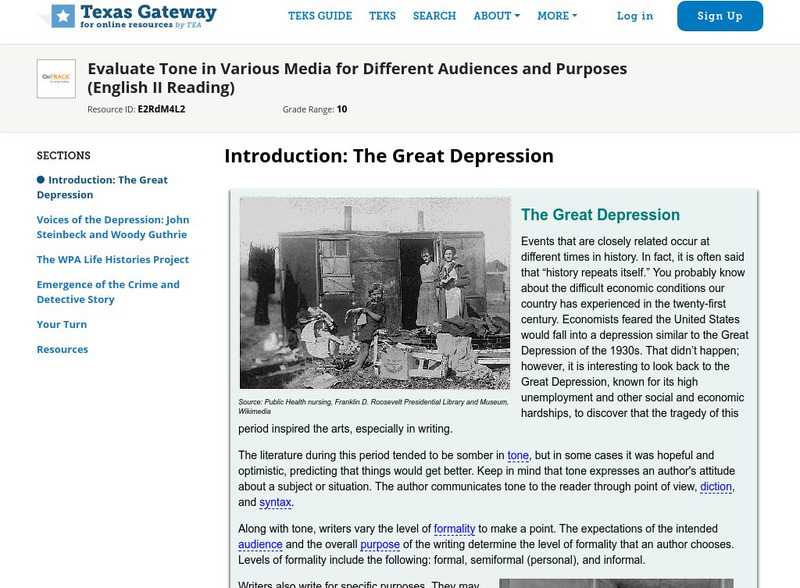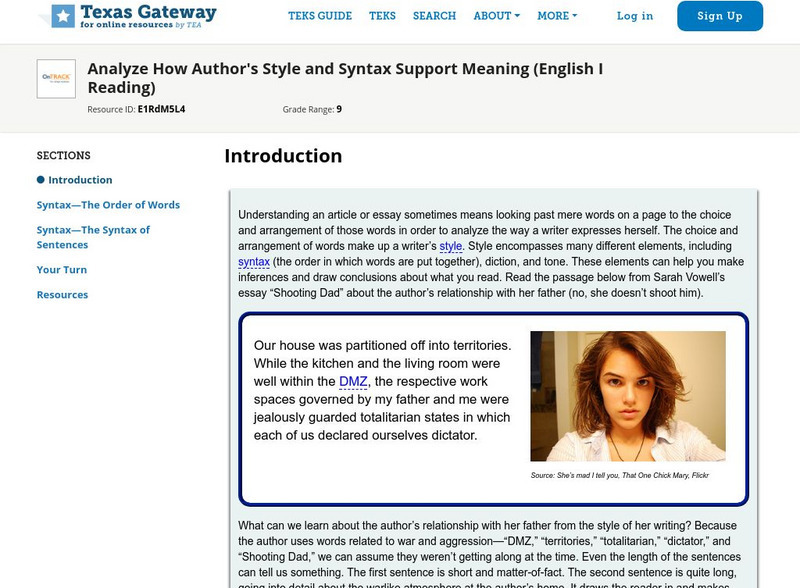Hi, what do you want to do?
Curated OER
Ornithology and Real World Science
Double click that mouse because you just found an amazing lesson! This cross-curricular Ornithology lesson incorporates literature, writing, reading informational text, data collection, scientific inquiry, Internet research, art, and...
Monarch High School
TP-CASTT Practice
Acronyms can help learners remember facts and analyze poetry. This resource includes graphic organizers for TP-CASTT, SOAPS, SOAPSTone, and DIDLS. Class members can try out one or all of these strategies to assist with that difficult job...
Curated OER
Review of Literary Devices
Sixth graders review literary devices. They use both fiction and nonfiction texts to review metaphor, simile, alliteration, imagery, symbolism and personification. This lesson has a scripted guide for the teacher to follow.
Shmoop
ELA.CCSS.ELA-Literacy.RL.11-12.6
It ‘s assessment check list time, and you have nothing to prove that your learners mastered the skill RL.11-12.6. Rest assured, here is a plan that is sure to appease your administrator. It offers solid examples on the difference...
Curated OER
The Declaration Versus The Communist Manifesto
Upper graders put their knowledge of the U.S. Constitution to the test when they are asked to mark which of several statements are from either the Constitution or the Communist Manifesto. A class discussion follows. Use this resource as...
Curated OER
The Way to Venezuela
Students investigate various facets of Venezuelan culture, politics, history and current events to develop an introductory chapter of a guidebook to the country.
Curated OER
Combing Through the News
Students use the Sean 'Puffy' Combs trial to compare how and why various media cover a news story differently.
Curated OER
E-tiquette
Students develop appropriate ways to communicate via e-mail. They evaluate examples of inappropriate e-mails and create preferable alternatives.
Curated OER
Lecture 6 - Oral Interpretation - Verse
Pupils discuss how oral interpretation varies with prose and poetry. They select a piece of prose or poetry to present to the class, and then assess each other on the organization and delivery of their speech as well as on their...
Curated OER
A Song By Any Other Name Would Be a Poem
Students examine the poetic elements of a piece of music. They discuss favorite songs, select a song, and write a persuasive essay identifying the poetic qualities of the song lyrics.
Curated OER
Screening the Silver Screen
Students write New York Times Movie Guide Reviews using descriptive and persuasive language.
Curated OER
Acting Like a Bunch of Animals: Fables and Human
The video "The Tales of Aesop" traces for viewers the history of fables and identifies their characteristics. The class then goes to the web site "The Fisherman and the Little Fish" where they examine the classic and a modern version of...
Curated OER
Children's Media and Censorship
Students examine the point of censorship when dealing with Students. They explore essays by Stephen King.
Curated OER
Concert Suite from Dances With Wolves
Students complete a unit of lessons that prepares them to perform, 'Concert Suite From Dances With Wolves,' at a public performance. They analyze the emotions depicted by music, view excerpts from the movie, and perform the music.
Curated OER
Looking for Newton
Students discuss the rhyming pattern of various types of poetry. With a focus on limericks, they follow the specific rhyme scheme and create a limerick about Newton. They share their poem with the class and write another one related to...
Texas Education Agency
Texas Gateway: Evaluate Tone in Various Media for Audiences and Purposes
This lesson features several weather videos, both real and created, to help students understand how information and the tone changes based on the audiences and the purposes for the presentation.
Texas Education Agency
Texas Gateway: Evaluate Tone in Various Media for Different Audiences & Purposes
This lesson will help you evaluate changes in formality and tone within printed texts written for specific audiences and purposes. It focuses on writing produced during the Great Depression.
Texas Education Agency
Texas Gateway: Diction and Tone (English Ii Reading)
This lesson will help students identify diction and tone in their reading and will help them answer these questions: What does the author mean? What is the author's attitude about what he or she is writing? How will my understanding of a...
Texas Education Agency
Texas Gateway: Diction and Tone (English I Reading)
Evaluate the diction in a text and discover the author's tone.
Texas Education Agency
Texas Gateway: Analyze How Author's Style and Syntax Support Meaning
This lesson focuses on understanding an article or essay by looking past mere words on a page to the choice and arrangement of those words in order to analyze the way writers express themselves. The choice and arrangement of words make...
Better Lesson
Better Lesson: Audience, Tone, and Style in Informative Text
Students will read samples of informative writing and highlight examples of how tone and style are used by the authors. Students will then apply this knowledge by writing their own informative text. Multiple examples of student work and...
Louisiana Department of Education
Louisiana Doe: Curriculum Hub: Ela Guidebooks: A Lesson Before Dying: Character, Tone and Theme
Ninth graders will read chapters 28- 31 of A Lesson Before Dying. They participate in a whole-class discussion about the changes that occur in the main characters and how these changes relate to lessons being learned. Students will...
Read Works
Read Works: Voice 3rd Grade Unit
[Free Registration/Login Required] A series of two lesson plans designed to teach students to recognize words and phrases that support the author's voice in poetry. Lessons are based on the books Where the Sidewalk Ends by Shel...
Texas Education Agency
Texas Gateway:diction and Tone (English I Reading)
In this learning module, the user will learn and apply the concepts of tone and diction. Tone is the author's attitude toward the writing. Tone is largely determined by diction or the words that an author chooses.




























